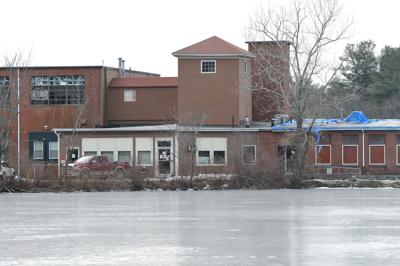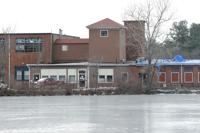Decades after first being apprised of the danger, state and local health officials are pledging to address widespread industrial contamination at the former Mansfield Bleachery complex off Morse Street.
The 22-acre site, adjacent to Glue Factory Pond and the nearby Rumford River, was home to a succession of industrial uses from the late 1800s to 1966 -- most notably glue manufacturing and later the signature bleachery operation.
Since then, health officials say, the property has been broken up into multiple small parcels under an evolving mosaic of ownership interests, making enforcement difficult.
While some of the aging buildings have been leased to a patchwork of commercial, manufacturing and recreational businesses, others stand abandoned -- and allegedly unsecured.
These, and other, details have been documented in a comprehensive report prepared by the University of Connecticut’s School of Engineering under a program which provides technical assistance to communities wrestling with sites affected by industrial contamination, more commonly known as brownfields.
The UConn report, presented Monday night to the board of health, outlines both a historical record and current snapshot of contamination, while stressing the need for more detailed environmental assessments before developing cleanup and funding options.
According to Owen Smyth, a UConn undergraduate student who spearheaded the project, five of the smaller parcels remain heavily contaminated with heavy metal dyes, inks, bleach, multi-color sludges and even low-intensity radioactive wastes -- as well as being littered with debris from unauthorized dumping over the years.
Smyth added that illegal dumping activities also extended beyond the property itself, with off-site landfills characterized by abandoned tanks, oil trucks and drums, junk cars, pools of discolored water, sold waste and refuse piles, floating petroleum products and stained soils.
“It was a bit dangerous to confirm all of these,” he said of a February inspection at the site. “There was a possibility that anywhere you stepped you could be stepping on an old rusted oil drum.”
Of the various smaller parcels, Smyth identified the 1.7-acre former “Summit Casting” foundry -- where a leaking 20,000-gallon underground storage tank was discovered and then removed in 1986 -- as most problematic.
Although the state Department of Environmental Protection at that time issued a notice of responsibility that covered the Summit Casting and three other parcels, a cleanup then estimated at $250,000 was never implemented, Smyth said, in part due to financial inability of the owners.
A connected 1.2-acre facility now used by a specialty business that recaptures freon from old appliances, is likewise heavily contaminated with mineral and other oils, dyes and both chemical and radioactive wastes – mostly likely by former tenants that included chemical and engineering firms.
Although numerous inspections have been conducted at locations throughout complex over the years, only the Summit Casting parcel was subjected a full-scale environmental assessment, Smyth said.
Attempting to explain why conditions at the Morse Street site have never been meaningfully addressed, Smyth suggested it can take decades for public opinion to coalesce and prompt an official response.
“It requires a level of engagement and information regarding the level of contamination that exists and the health effects thereof,” he said.
Local public health Director Matthew Brennan agreed.
“This is the education piece,” Brennan said, referring to the UConn report. “Right now, we’re bringing it to the public. The next step is really figuring out what we want to do – how do we get access, what grants do we go for, who we get involved.”
Information included in the voluminous report was compiled from prior site inspections and environmental assessments, historical documents and local property and assessors’ records.
Going forward, Smyth recommended that updated environmental evaluations and hazardous building assessments be undertaken on all parcels and remaining structures – adding the federal Environmental Protection Agency offers grants to help with particularly complex situations.
“Their construction history is relatively unknown,” he said of most surviving buildings at the complex, including those still being used. “There is not any up-to-date report on their building materials, and as such there is a large potential for leaded paints, leaded pipes and asbestos-containing insulators.”
Health board member Sophia Manos voiced frustration at the scant progress made at the complex since the mid-1980s, while contending that, in the near term, the site should be secured as a public safety risk.
“Even though it’s critically important, some things need to hit the heart a little bit closer,” Manos said. “I just don’t see why kids need to be exposed to any of this stuff.”
Participating remotely in Monday’s presentation, Angela Gallagher from the Massachusetts Dept. of Environmental Protection’s southeast regional office, said the former bleachery site remains on the agency’s radar.
“Just so you do know, Mass DEP is aware and already had been working on this,” Gallagher said. “It hasn’t been lost and I do understand your frustration. We have been doing a lot of research and (the U-Conn report) has been extremely helpful.”
Following Smyth’s presentation, Chairwoman Betsy Allo said it was helpful to see the litany of ecological issues – most acknowledged years ago by state and local officials – all compiled in a single document.
In response to questioning by fellow board member Robin Chapell, Smyth explained that U-Conn could assist local officials in preparing grant applications.
“Seeing that there is some contamination there we should be concerned about it, and we should move forward,” Chapell said.
Karl VandenBoom of 109 Morse St. thanked board for raising awareness of long-standing problems at the site.
“It’s been a lot time coming,” he said. “It’s awesome to hear it’s going to be looked at.”
VandenBoom said teenagers use portions of the site as a hangout, adding he has observed barrel fires burning inside the abandoned Summit Casting building.
“It’s crazy,” he said. “At a minimum I think the buildings should be locked up, fenced down or torn down at this point.”
UConn’s technical assistance program has helped develop environmental assessments at industrial sites throughout New England, including a 2022 project to establish a brownfields inventory for the City of Attleboro.
Smyth, who previously focused on a former dying facility in Killingly, Conn., said he expects to generate a similar report on the Evelyn Porter estate off Cocasset Street this summer.










